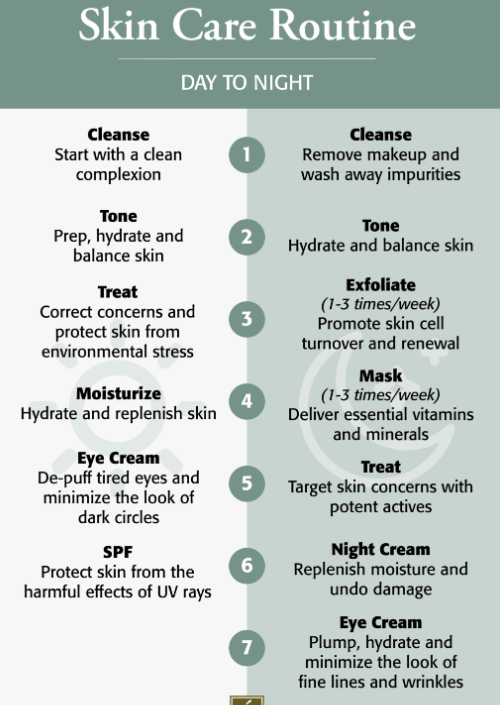BOURSESSENEGAL – Creating a personalized skincare routine is essential for maintaining healthy skin. Whether you struggle with acne, dryness, or signs of aging, the right regimen can significantly improve your skin’s appearance and texture. In this comprehensive guide, we’ll explore the steps involved in developing an effective skincare routine tailored to your skin type and concerns.
Understanding Your Skin Type
Different Skin Types
Before you can create a skincare routine, you need to understand your skin type. Generally, skin types fall into four categories:
- Oily Skin: This skin type produces excess oil, leading to a shiny appearance and potential breakouts.
- Dry Skin: Characterized by a lack of moisture, dry skin can feel tight, flaky, or rough.
- Combination Skin: This type features both oily and dry areas, typically with an oily T-zone (forehead, nose, and chin).
- Sensitive Skin: Sensitive skin reacts easily to products or environmental factors, leading to redness, itching, or irritation.
How to Determine Your Skin Type
To identify your skin type, wash your face with a gentle cleanser and wait for an hour. Observe how your skin feels:
- If it looks shiny and feels greasy, you likely have oily skin.
- If it feels tight or looks flaky, you probably have dry skin.
- If some areas are oily while others are dry, you have combination skin.
- If your skin reacts negatively to products or environmental changes, you have sensitive skin.
Building Your Skincare Routine
Step 1: Cleansing
The first step in any skincare routine is cleansing. This removes dirt, oil, and makeup, preparing your skin for the next steps.
Choosing the Right Cleanser
- Oily Skin: Opt for a gel or foaming cleanser containing salicylic acid or tea tree oil to combat excess oil.
- Dry Skin: Choose a creamy or hydrating cleanser with ingredients like glycerin or hyaluronic acid.
- Combination Skin: Use a gentle foaming cleanser that balances both oily and dry areas.
- Sensitive Skin: Look for fragrance-free, gentle cleansers with soothing ingredients like aloe vera or chamomile.
Step 2: Exfoliating
Exfoliation removes dead skin cells, promoting a smoother complexion. However, it’s crucial not to overdo it.
Types of Exfoliants
- Physical Exfoliants: Scrubs with granules that manually slough off dead skin. Use these 1-2 times a week.
- Chemical Exfoliants: AHAs (alpha hydroxy acids) and BHAs (beta hydroxy acids) dissolve dead skin cells. Depending on your skin type, use these 1-3 times a week.
Step 3: Toning
Toners help balance your skin’s pH and remove any remaining impurities after cleansing.
Choosing a Toner
- Oily Skin: Look for a toner with witch hazel or salicylic acid to control oil and prevent breakouts.
- Dry Skin: Hydrating toners with ingredients like rose water or glycerin can soothe and moisturize.
- Combination/Sensitive Skin: Opt for alcohol-free toners that are gentle on the skin.
Step 4: Treatment
This step involves applying serums or spot treatments to target specific skin concerns.
Popular Treatments
- Acne Treatments: Ingredients like benzoyl peroxide and salicylic acid can effectively reduce breakouts.
- Anti-aging Treatments: Serums with retinol or peptides can help minimize fine lines and wrinkles.
- Brightening Treatments: Vitamin C serums can improve skin tone and radiance.
Step 5: Moisturizing
Moisturizing is crucial for all skin types, even oily skin. A good moisturizer locks in hydration and protects the skin barrier.
Selecting the Right Moisturizer
- Oily Skin: Lightweight, oil-free gel moisturizers work best.
- Dry Skin: Cream-based moisturizers with hyaluronic acid or ceramides provide deep hydration.
- Combination Skin: A balanced moisturizer that hydrates without adding excess oil is ideal.
- Sensitive Skin: Fragrance-free, soothing moisturizers help calm irritation.
Step 6: Sun Protection
Applying sunscreen daily is essential to protect your skin from harmful UV rays, which can lead to premature aging and skin cancer.
Choosing the Right Sunscreen
- Look for broad-spectrum protection with at least SPF 30.
- For oily skin, opt for gel-based or matte-finish sunscreens.
- Dry skin benefits from hydrating sunscreens with added moisturizers.
Nighttime Routine
Your nighttime skincare routine should be slightly different since your skin undergoes repair while you sleep.
Key Steps for Nighttime Care
- Double Cleansing: Consider using an oil cleanser followed by a gentle cleanser to remove makeup and impurities effectively.
- Serums: Apply targeted serums, focusing on treatments for acne, aging, or pigmentation.
- Night Cream: Use a richer moisturizer or overnight mask to deeply nourish your skin while you sleep.
Seasonal Skincare Adjustments
Adapting Your Routine
As seasons change, so do your skin’s needs. In winter, you might need heavier moisturizers due to dryness, while summer may call for lighter products.
Tips for Seasonal Care
- Winter: Use thicker creams and consider adding a humidifier to maintain moisture levels in your environment.
- Summer: Focus on lightweight products and don’t forget the sunscreen.
Listening to Your Skin
Adjusting Your Routine
Always pay attention to how your skin responds to products. If you experience irritation, redness, or breakouts, reassess your routine. Sometimes, less is more.
Patch Testing
Before introducing new products, do a patch test. Apply a small amount on a discreet area of your skin and observe for any reactions over 24 hours.
Conclusion: Embrace Your Skincare Journey
Creating an effective skincare routine takes time and experimentation. With the right products tailored to your skin type and concerns, you can achieve healthy, glowing skin. Remember, consistency is key. Stick to your routine, and don’t hesitate to adjust it as needed. Your skin deserves the best care possible!
By following this guide, you can confidently navigate your skincare journey and discover what works best for you. Embrace the process, and enjoy the benefits of radiant, healthy skin!
REFERENCE : https://www.health.com/



